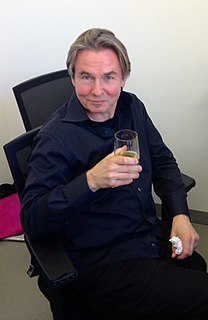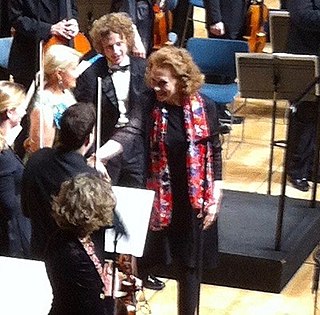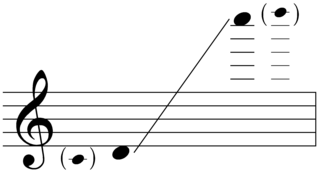
Music for Strings, Percussion and Celesta, Sz. 106, BB 114 is one of the best-known compositions by the Hungarian composer Béla Bartók. Commissioned by Paul Sacher to celebrate the tenth anniversary of the chamber orchestra Basler Kammerorchester, the score is dated September 7, 1936.

Esa-Pekka Salonen is a Finnish orchestral conductor and composer. He is principal conductor and artistic advisor of the Philharmonia Orchestra in London, conductor laureate of the Los Angeles Philharmonic, and music director-designate of the San Francisco Symphony.
The Turangalîla-Symphonie is a large-scale piece of orchestral music by Olivier Messiaen (1908–92). It was written from 1946 to 1948 on a commission by Serge Koussevitzky for the Boston Symphony Orchestra. The premiere was in Boston on 2 December 1949, conducted by Leonard Bernstein. The commission did not specify the duration, orchestral requirements or style of the piece, leaving the decisions to the composer. Koussevitzky was billed to conduct the premiere, but fell ill, and the task fell to the young Bernstein. Bernstein has been described as "the ideal conductor for it, and it made Messiaen's name more widely known". Yvonne Loriod, who later became Messiaen's second wife, was the piano soloist, and Ginette Martenot played the ondes Martenot for the first and several subsequent performances. From 1953, Yvonne's sister Jeanne Loriod was the ondes Martenot player in many performances and recordings.
Dawn Upshaw is an American soprano. The recipient of several Grammy Awards and Edison Prize-winning discs, she performs both opera and art song, and in repertoire from Baroque to contemporary. Many composers, including Henri Dutilleux, Osvaldo Golijov, John Harbison, Esa-Pekka Salonen, John Adams, and Kaija Saariaho, have written for her. In 2007, she was awarded a MacArthur Fellowship.

Kent George Nagano is an American conductor and opera administrator. He is currently music director of the Montreal Symphony Orchestra since 2006, and general music director of the Hamburg State Opera since 2015.
The Avanti! Chamber Orchestra is a Finnish ensemble that focuses on contemporary music. The ensemble when it performs varies in size from a solo player to a symphony orchestra. Avanti! Chamber Orchestra won the Gramophone Prize with their first recording. The Orchestra also holds a music festival of its own each summer.
The Second Concerto for Orchestra is a concerto for orchestra by the American composer Steven Stucky. The work was commissioned by the Los Angeles Philharmonic while Stucky was their composer-in-residence for the inaugural season of the Walt Disney Concert Hall. It was completed in 2003 and was first performed on March 12, 2004, with the conductor Esa-Pekka Salonen leading the Los Angeles Philharmonic. The piece was awarded the 2005 Pulitzer Prize for Music.
The Piano Concerto is a concerto for solo piano and orchestra in three movements by the Finnish composer Esa-Pekka Salonen. The work was jointly commissioned by the New York Philharmonic, the BBC, the NDR Symphony Orchestra, and Radio France. It was premiered February 1, 2007 in Avery Fisher Hall, New York City, with Salonen conducting the pianist Yefim Bronfman and the New York Philharmonic. Salonen dedicated the piece to Yefim Bronfman.
Nyx is a symphonic poem by the Finnish composer Esa-Pekka Salonen. The work was jointly commissioned by Radio France, the Barbican Centre, the Atlanta Symphony Orchestra, Carnegie Hall, and the Finnish Broadcasting Company. It was premiered February 19, 2011 in the Théâtre du Châtelet, Paris, with Salonen conducting the Orchestre Philharmonique de Radio France. The piece is titled after the Goddess Nyx from Greek mythology.
Wing on Wing is a single-movement composition for two sopranos and orchestra by the Finnish composer Esa-Pekka Salonen. The work was commissioned by the Los Angeles Philharmonic for their inaugural season at the Walt Disney Concert Hall and was premiered June 5, 2004 by the orchestra under Salonen. The piece is dedicated to the architect Frank Gehry, the acoustician Yasuhisa Toyota, and the L.A. Philharmonic CEO Deborah Borda.
Stockholm Diary is a composition for string orchestra by the Finnish composer Esa-Pekka Salonen. The work was commissioned by the Stockholm Concert Hall Foundation for the Royal Stockholm Philharmonic Orchestra and the Stockholm Chamber Orchestra. It was first performed in Stockholm, October 27, 2004, by the Royal Stockholm Philharmonic Orchestra under Salonen.
Foreign Bodies is an orchestral composition in three movements by the Finnish composer Esa-Pekka Salonen. The work was commissioned by the Finnish Broadcasting Company and was first performed at the Schleswig-Holstein Musik Festival on August 12, 2001 by the Finnish Radio Symphony Orchestra under the conductor Jukka-Pekka Saraste.
True Fire is a song cycle for solo baritone and orchestra by the Finnish composer Kaija Saariaho. The work was jointly commissioned by the Los Angeles Philharmonic, the NDR Symphony Orchestra, the BBC Symphony Orchestra and the Orchestre National de France. It was first performed at the Walt Disney Concert Hall in Los Angeles on May 14, 2015, by the baritone Gerald Finley and Los Angeles Philharmonic under the conductor Gustavo Dudamel. The piece is dedicated to Gerald Finley.
Notes on Light is a cello concerto by the Finnish composer Kaija Saariaho. The work was commissioned by the Boston Symphony Orchestra and was first performed at Symphony Hall, Boston on February 22, 2007, by the cellist Anssi Karttunen and the Boston Symphony Orchestra under the conductor Jukka-Pekka Saraste.
D'Om le Vrai Sens is a clarinet concerto by the Finnish composer Kaija Saariaho. The work was jointly commissioned by the Finnish Radio Symphony Orchestra, the BBC, the Fundação Casa da Musica, the Swedish Radio Symphony Orchestra, and Radio France. It was given its world premiere by the clarinetist Kari Kriikku and the Finnish Radio Symphony Orchestra under the conductor Sakari Oramo in Finlandia Hall, Helsinki, on September 8, 2010. The concerto is dedicated to Kari Kriikku.
Fresco is an orchestral composition by the Finnish composer Magnus Lindberg. The work was commissioned by the Los Angeles Philharmonic. Its world premiere was given in Los Angeles on March 12, 1998 by the Los Angeles Philharmonic under the direction of Esa-Pekka Salonen, to whom the piece is dedicated.
Sculpture is an orchestral composition by the Finnish composer Magnus Lindberg. The music was commissioned by the Los Angeles Philharmonic with support from the Koussevitzky Music Foundation to celebrate the orchestra's inaugural season at the Walt Disney Concert Hall. Its world premiere was given by the Los Angeles Philharmonic under the direction of Esa-Pekka Salonen on October 6, 2005.
Parada is an orchestral composition by the Finnish composer Magnus Lindberg. The piece was composed for the music festival Related Rocks which celebrates the works of Lindberg and related composers. Its world premiere was given at The Anvil, Basingstoke on February 6, 2002 by the Philharmonia Orchestra under the direction of Esa-Pekka Salonen, to whom the work is dedicated.
Karawane is a composition for chorus and orchestra by the Finnish composer Esa-Pekka Salonen. The work was jointly commissioned by the Tonhalle Orchester Zürich, the Swedish Radio Symphony Orchestra, the New York Philharmonic with support from the philanthropist Marie-Josée Kravis, the Bamberg Symphony, and the Finnish Radio Symphony Orchestra. It was first performed by the Tonhalle Orchester Zürich and the Zürcher Sing-Akademie conducted by Lionel Bringuier in the Tonhalle, Zürich, on September 10, 2014. The piece is set to the eponymous poem by the German author and Dadaist Hugo Ball.














